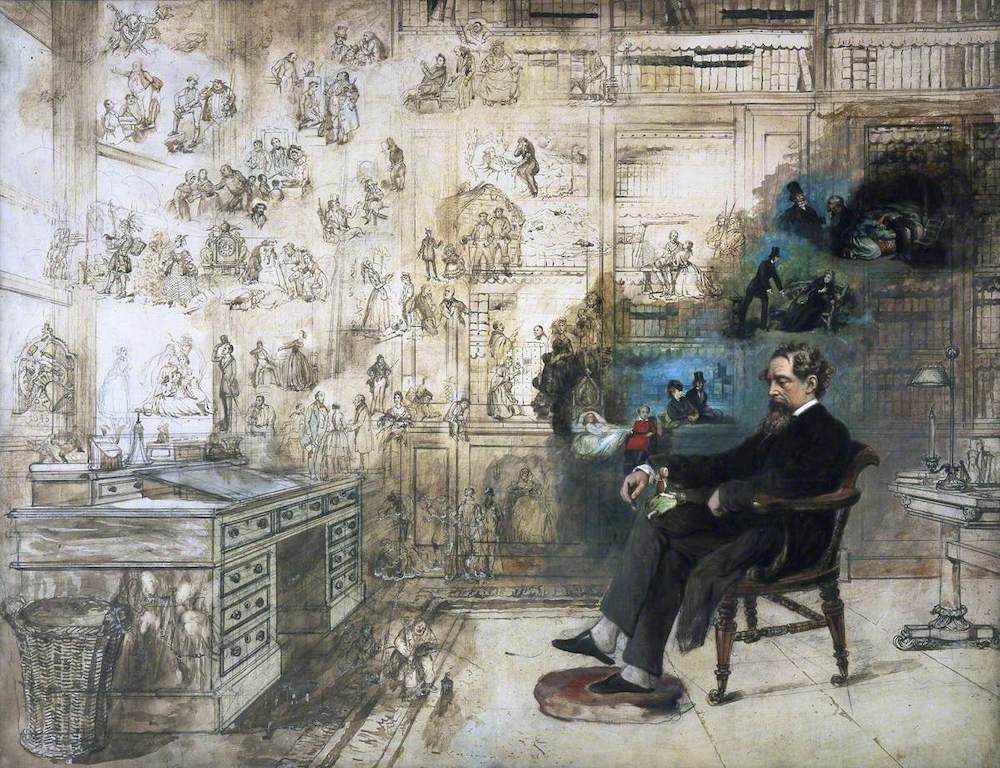
A Souvenir of Dickens (also known as Dickens's Dream) by Robert William Buss. Image credit: Charles Dickens Museum, London. Reproduced via Art UK under under the terms of the Creative Commons Attribution-NonCommercial-ShareAlike licence (CC BY-NC-SA). [Click on the image to enlarge it.]
Ironically, the artist who created Dickens's Dream (1875), a famous memorial portrait that depicted the novelist surrounded by his characters, lost his job as an illustrator of Dickens: Chapman and Hall, publishers of Pickwick, fired him after he had completed only two engravings for the June 1836 issue of the novel.
This is how events unfolded. The publishers desperately needed a replacement for Robert Seymour, who committed suicide on 20 April 1836, and hired Buss. According to Jane Rabb Cohen, Chapman and Hall “left vague whether Buss's tenure was for the 'ensuing' number only or for as long as he gave satisfaction. Buss obviously assumed both that he would be well paid for his efforts and that he was likely to continue as Pickwick's illustrator throughout its publication. It was certainly clear to Buss that the publisher's plight was desperate and that his help would be invaluable. Pressed by Hall, flattered by [having been recommended], awed by the reputation of his predecessor, and impressed by Dickens's writing, Buss agreed to submit a sample of his qualifications to follow Seymour” (53).
Since Seymour had already completed three of the necessary plates, the next instalment (no. 2) came out on schedule at the end of April with four plates and 28 pages of text. Now Buss had just three weeks to perfect himself in a new craft. Putting aside his painting, he spent these weeks preparing a number of preliminary sketches for the novel in hopes of being retained as Dickens's principal illustrator after the publication of the third (June) instalment (five of these sketches are in the Pierpont Morgan Library, New York). These proved acceptable. But although Buss had served an apprenticeship with his father, a master engraver and enameller, his work on the pair of steel-engravings tentatively entitled The Arbour Scene and The Cricket Match, show that he was not a skilled engraver on steel. Chapman and Hall, summarily dismissed him when they saw his apprentice engravings of the scenes.
As for Dickens's work, his biographer Peter Ackroyd explains that Chapman and Hall then “came up with the idea that saved the project and helped to increase its success: it was suggested that [Dickens] should write an extra half a sheet (or eight pages) each month and that the quantity of illustrations should be halved to two plates. In other words, he was able to take command of the project and to proceed with it in a manner unhampered by the demands for too many illustrations or by the requests of a too-powerful illustrator” (183). The Pickwick commission then passed to Hablot Knight Browne or 'Phiz' as he was affectionately known to the Victorians.
Buss, poor fellow, who had lost the opportunity to play a major role in one of the greatest Victorian publication successes, "locked up his engraving tools and destroyed much of his work relating to The Pickwick Papers. For the rest of his life, it was said, he could not bear to have the matter mentioned in his presence" (Ackroyd 183). However, it says much about his character that he never blamed Dickens, of whom he remained a life-long admirer.


Early black-and-white versions of Buss's famous painting. Left: A transposed version from William Glyde Wilkins and B. W. Matz's Charles Dickens in Caricature and Cartoon (Boston: The Bibliophile Society, 1924). Right: Another one in Frederic George Kitton's Dickens and his illustrators.... (London: Redway, 1899, following p.52).
At this time, incidentally, Buss did illustrate "A little talk about Spring and the Sweeps" on its first appearance in The Library of Fiction; or, Family Story-Teller; Consisting of Original Tales, Essays and Sketches of Characters No. III, published by Chapman and Hall for June, 1836. But after his Pickwick misadventure, he turned back to his main interest, painting, producing theatrical portraits of leading actors of the day, such as William Macready, John Pritt Harley, and John Baldwin Buckstone. He later turned to moving to historical subjects. Between the start of his career as a painter in 1826 and his semi-retirement in 1859, Buss exhibited 112 paintings, twenty-five at the Royal Academy, twenty at the British Institution, forty-five at the Suffolk Street Gallery of the Society of British Artists, and seven at the New Watercolour Society.
Sadly for Buss, when the volume edition was about to appear, Chapman and Hall replaced Buss's pair of illustrations with a more incisive and humorous set by Phiz. Phiz's farcical tableau Wardle & his friends under the influence of "the Salmon" replaced the lacklustre, undistinguished The Cricket Match.
Works
- The Cricket Match [Part 3, Chapter 7: All-Muggleton vs.Dingley-Dell]
- The Arbour Scene [Part 3, Chapter 8: Emily Wardle; Joe, the Fat Boy; and Tracy Tupman]
- Dickens's Dream [1875, shown above, based on Sir Luke Fildes' The Empty Chair (1870)]
Other Artists Who Illustrated Pickwick, 1836-1910
- Robert Seymour (April-May, 1836)
- Phiz (Hablot Knight Browne) 1836-37
- Thomas Onwhyn (1837)
- Felix Octavius Carr Darley (1861)
- Sol Eytinge, Jr. (1867)
- Thomas Nast (1873)
- Harry Furniss (1910)
- Clayton J. Clarke's Extra Illustrations for Player's Cigarettes (1910)
Bibliography
Ackroyd, Peter. Chapter 8. Dickens London: Sinclair-Stevenson, 1990. 174-200.
Cohen, Jane Rabb. Chapter 3: "Robert Buss." Charles Dickens and His Original Illustrators. Columbus: Ohio State U. P., 1980. 51-58.
Dickens, Charles. The Posthumous Papers of the Pickwick Club. Illustrated by Robert Seymour, R. W. Buss, and Hablot Knight Browne ('Phiz'). London: Chapman & Hall: April 1836 through November 1837.
Jarvis, Stephen. Death and Mr. Pickwick. New York: Farrar, Straus and Giroux, 2015.
Last modified 1 November 2024